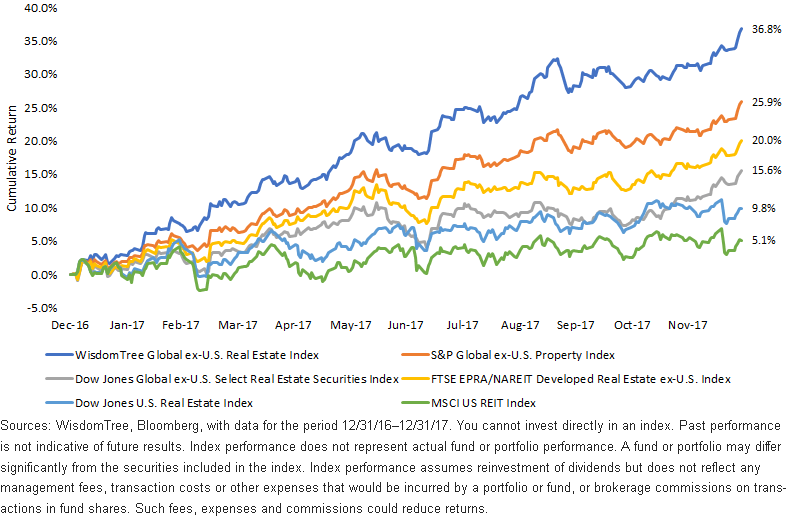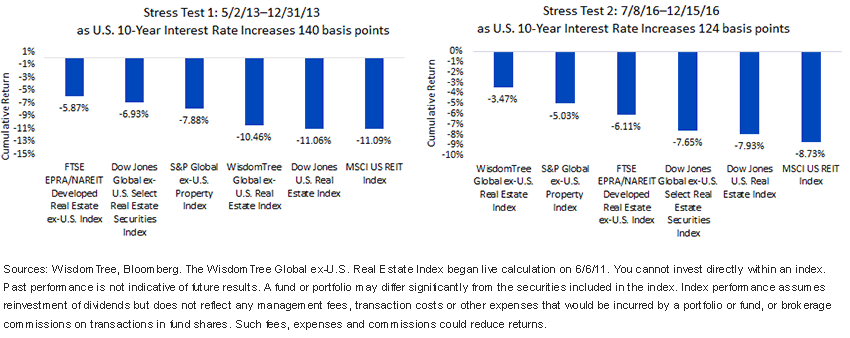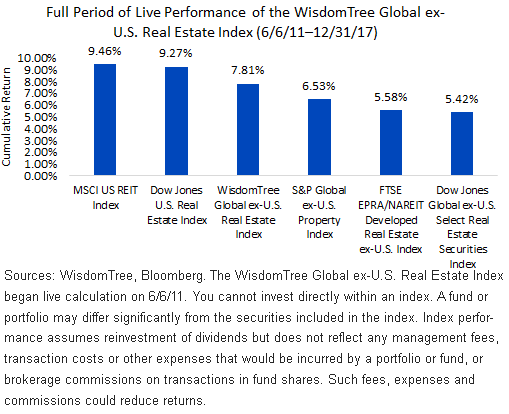Global ex-U.S. Real Estate Goes on a 2017 Run


One of the best performing WisdomTree strategies in 2017 was the WisdomTree Global ex-U.S. Real Estate Index—which was up nearly 37% last year.1
Global ex-U.S. Real Estate Broadly Outperforms U.S. Real Estate in 2017

Please visit our glossary for definitions of indexes in the chart.
- China as a Critical Driver: One of the most powerful factors in global markets in 2017 has been the performance of China. Within the WisdomTree Global ex-U.S. Real Estate Index, almost 30% of the nearly 37% return that we’ve seen has been driven by China, which, with an 8.2% average weight, has delivered a return greater than 180%.2
- WisdomTree Already Has Trimmed Exposure to China: Many might look at that number and assume that they have missed the rally—triple-digit returns rarely repeat themselves in short order. WisdomTree’s approach has been based on following fundamentals rather than share price performance (and hence increased market capitalization). As a result of the Sept. 30, 2017, Index screening, the weight allocated to China dropped by about 8%.3 That emphasizes a natural, annual discipline to shift weight away from price performance that has extended furthest beyond the fundamentals.
Investors Have Grown Comfortable with the Outperformance of U.S. Real Estate over Global ex-U.S. Real Estate
When the argument is made for global diversification of equities, an index such as the MSCI ACWI Investable Market Index is frequently cited and people are reminded that only about 50% to 52% of the weight is in the United States—even if many U.S. investors far exceed this with their inherent “home bias.”4
Although it’s done far less often, those thinking about real estate can undergo a similar exercise, taking the FTSE EPRA/NAREIT United States Index and the FTSE EPRA/NAREIT Global ex-U.S. Index5.
- The FTSE EPRA/NAREIT United States Index had a market capitalization of $820 billion.
- The FTSE EPRA/NAREIT Global ex-U.S. Index had a market capitalization of $1.4 trillion.
On a percentage basis, this tells us that almost two-thirds of the global real estate opportunity is outside of the United States—but we’d ask how many investors have any non-U.S. dedicated real estate exposure within their asset allocations.
Achilles’ Heel of Real Estate: Rising Rates
Now, we recognize that we can’t write about real estate as an asset class without addressing the 800-pound gorilla in the room—the fact that interest rates have been very low for an extended period and that they may be headed higher. We couldn’t say exactly how much higher or how quickly the changes could occur, but the past few years could be used to provide some interesting “stress tests” of what may happen.
We’ve Seen a Few Periods Where the U.S. 10-Year Interest Rate Has Risen Significantly—and Fast!

Please visit our glossary for definitions of indexes in the chart.
- Stress Test 1: During this period, it was very difficult for any strategy that had significant exposure to emerging market assets, as the term “taper tantrum” could ring a bell. The WisdomTree Global ex-U.S. Real Estate Index does tend to be over-weight in emerging markets real estate relative to the other non-U.S. real estate indexes shown. However, even with this disadvantage, all of the non-U.S. real estate indexes outperformed the two U.S. real estate indexes shown.
- Stress Test 2: This period, while seeing a big increase in the U.S. 10-Year Treasury interest rate, saw much better emerging market performance. The WisdomTree Index lost the least over this period, while, notably, the two U.S. real estate indexes shown again lost the most.
U.S. Real Estate May Have Outperformed Recently, but Non-U.S. Held Its Own in a Strong Dollar Environment

Please visit our glossary for definitions of indexes in the chart.
- Since the WisdomTree Index’s inception, the 10-Year U.S. Treasury interest rate declined by about 58 basis points, and the U.S. trade-weighted dollar appreciated by about 3.5% per year. These factors give the advantage to the two U.S. real estate indexes shown—and they’ve delivered strong performance, to be sure. However, the WisdomTree Global ex-U.S. Real Estate Index wasn’t that far behind, especially considering that dollar appreciation tends to be a direct headwind. If we enter into a period where rates tend to rise and the dollar tends to be flat to even a bit weaker, that could shift conditions more in favor of non-U.S. real estate.
WisdomTree’s Global ex-U.S. Real Estate Toolkit
Things such as interest rates and the dollar have ebbed and flowed in distinct trends that, while difficult to forecast exactly, have tended to repeat themselves over time. Along this line, WisdomTree has created two strategies to address this:
- The WisdomTree Global ex-U.S. Real Estate Fund (DRW), designed to track the performance of the WisdomTree Global ex-U.S. Real Estate Index, the WisdomTree Index discussed in this piece.
- The WisdomTree Global ex-U.S. Hedged Real Estate Fund (HDRW), designed to track the performance of the WisdomTree Global ex-U.S. Hedged Real Estate Index. This Index neutralizes the impact of the performance of the U.S. dollar against foreign currencies, but it has been live only since September 1, 2015, so it was not shown within the analysis of this piece.
1Source: Bloomberg, with data for the period 12/31/16–12/31/17.
2Source for full bullet list: Bloomberg, with data for the period 12/31/16–12/31/17.
3Sources: WisdomTree, Standard & Poor’s. Data is measured as of the 930/17 Index screening date. Approximately 6% of the reduction in weight concerned adjustments for free float and 2% was due to price and dividend movements.
4Sources: WisdomTree, Bloomberg, with data as of 12/31/17.
5Source for bullets: Bloomberg, with data as of 12/31/17.
Important Risks Related to this Article
There are risks associated with investing, including possible loss of principal. Foreign investing involves special risks, such as risk of loss from currency fluctuation or political or economic uncertainty. Investments in emerging, offshore or frontier such as the Middle East are generally less liquid and less efficient than investments in developed markets and are subject to additional risks, such as risks of adverse governmental regulation and intervention or political developments. Investments in real estate involve additional special risks, such as credit risk, interest rate fluctuations and the effect of varied economic conditions. Funds focusing their investments on certain sectors companies increase their vulnerability to any single economic or regulatory development. This may result in greater share price volatility. The Fund uses various strategies to attempt to minimize the impact of changes in applicable foreign currencies against the U.S. dollar, which may not be successful. Investments in derivative investments can be volatile, may be less liquid than securities and may be more sensitive to the effect of varied economic conditions. The Fund invests in the securities included in, or representative of, its Index regardless of their investment merit and the Fund does not attempt to outperform its Index or take defensive positions in declining markets. Please read the Funds’ prospectuses for specific details regarding the Fund’s risk profile.

Christopher Gannatti began at WisdomTree as a Research Analyst in December 2010, working directly with Jeremy Schwartz, CFA®, Director of Research. In January of 2014, he was promoted to Associate Director of Research where he was responsible to lead different groups of analysts and strategists within the broader Research team at WisdomTree. In February of 2018, Christopher was promoted to Head of Research, Europe, where he was based out of WisdomTree’s London office and was responsible for the full WisdomTree research effort within the European market, as well as supporting the UCITs platform globally. In November 2021, Christopher was promoted to Global Head of Research, now responsible for numerous communications on investment strategy globally, particularly in the thematic equity space. Christopher came to WisdomTree from Lord Abbett, where he worked for four and a half years as a Regional Consultant. He received his MBA in Quantitative Finance, Accounting, and Economics from NYU’s Stern School of Business in 2010, and he received his bachelor’s degree from Colgate University in Economics in 2006. Christopher is a holder of the Chartered Financial Analyst Designation.

